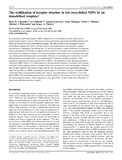- CERES Home
- →
- Cranfield Health
- →
- Staff publications - Cranfield Health
- →
- View Item
JavaScript is disabled for your browser. Some features of this site may not work without it.
| dc.contributor.author | Garcinuno, Rosa M. | - |
| dc.contributor.author | Chianella, Iva | - |
| dc.contributor.author | Guerreiro, Antonio R. | - |
| dc.contributor.author | Mijangos, Irene | - |
| dc.contributor.author | Piletska, Elena V. | - |
| dc.contributor.author | Whitcombe, Michael J. | - |
| dc.contributor.author | Piletsky, Sergey A. | - |
| dc.date.accessioned | 2012-02-03T23:05:42Z | |
| dc.date.available | 2012-02-03T23:05:42Z | |
| dc.date.issued | 2009-01-21T00:00:00Z | - |
| dc.identifier.citation | Garcinuno RM, Chianella I, Guerreiro A, et al., (2009) The stabilisation of receptor structure in low cross-linked MIPs by an immobilised template, Soft Matter, 2009, Issue 5, Pages 311–317 | - |
| dc.identifier.issn | 1744-683X | - |
| dc.identifier.uri | http://dx.doi.org/10.1039/b804476g | - |
| dc.identifier.uri | http://dspace.lib.cranfield.ac.uk/handle/1826/6955 | |
| dc.description.abstract | In molecularly imprinted polymers (MIPs) a high level of cross-linking is usually important for preserving the receptor structure. We propose here an alternative approach for stabilising binding sites, which involves the use of an immobilised template. The idea is based on the assumption that an immobilised template will ‘‘hold’’ polymeric chains and complementary functionalities together, preventing the collapsing of the binding sites. To test this postulate, a range of polymers was prepared using polymerisable (2,4-diamino-6- (methacryloyloxy)ethyl-1,3,5-triazine) and non-polymerisable (or extractable) (2,4-diamino-6-methyl-1,3,5-triazine) templates, methacrylic acid as functional monomer and ethylene glycol dimethacrylate as cross-linker. The level of cross-linking was varied from 12 to 80%. Polymerisations were performed in acetonitrile using UV initiation. Binding properties of the synthesised materials were characterised both by HPLC and equilibrium batch binding experiments followed by HPLC-MS or UV-visible detection. The adsorption isotherms of polymers were obtained and fitted to the Langmuir model to calculate dissociation constant, Kd, and concentration of binding sites for each material. The results strongly indicate that the presence of an immobilised template improves the affinity of MIPs containing low percentages of cross-linker. The low cross-linked MIPs synthesised with a polymerisable template also retain a reasonable degree of selectivity. Low crosslinked MIPs with such binding characteristics would be useful for the creation of new types of optical and electrochemical sensors, where induced fit or the ‘‘gate effect’’ could be used more effectively for generating and enhancing sensor signals. | en_UK |
| dc.language.iso | en_UK | - |
| dc.publisher | Royal Society of Chemistry | en_UK |
| dc.title | The stabilisation of receptor structure in low cross-linked MIPs by an immobilised template | en_UK |
| dc.type | Article | - |
